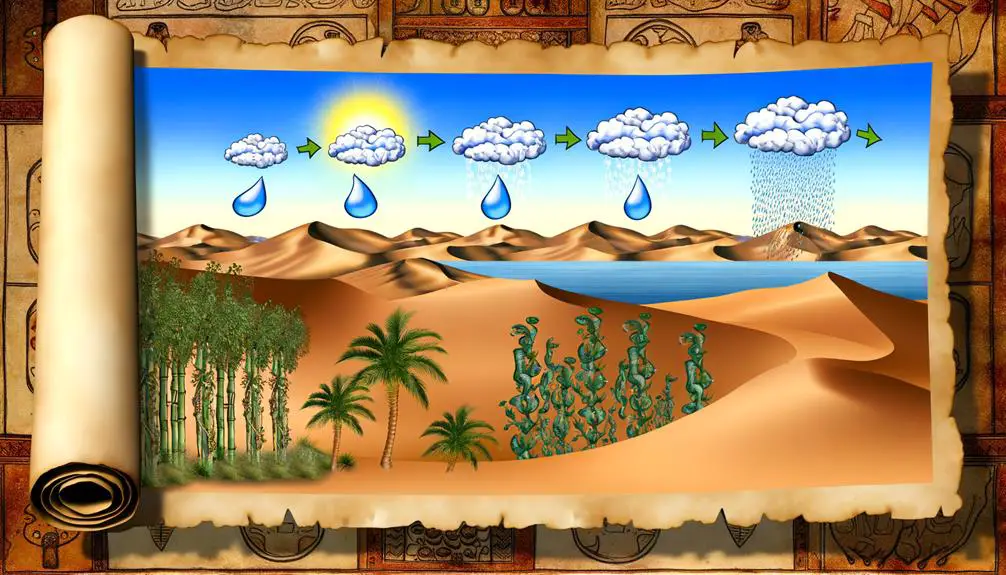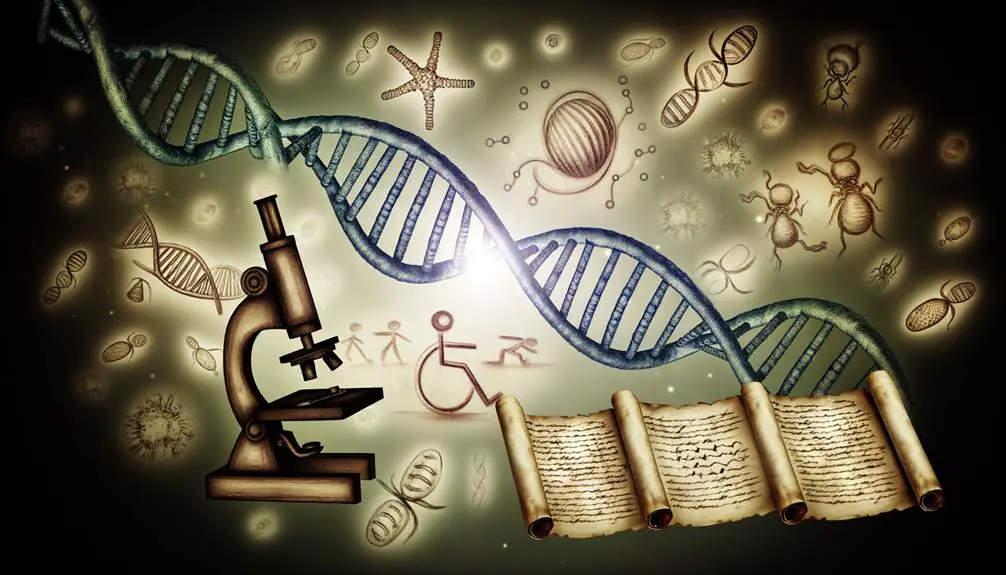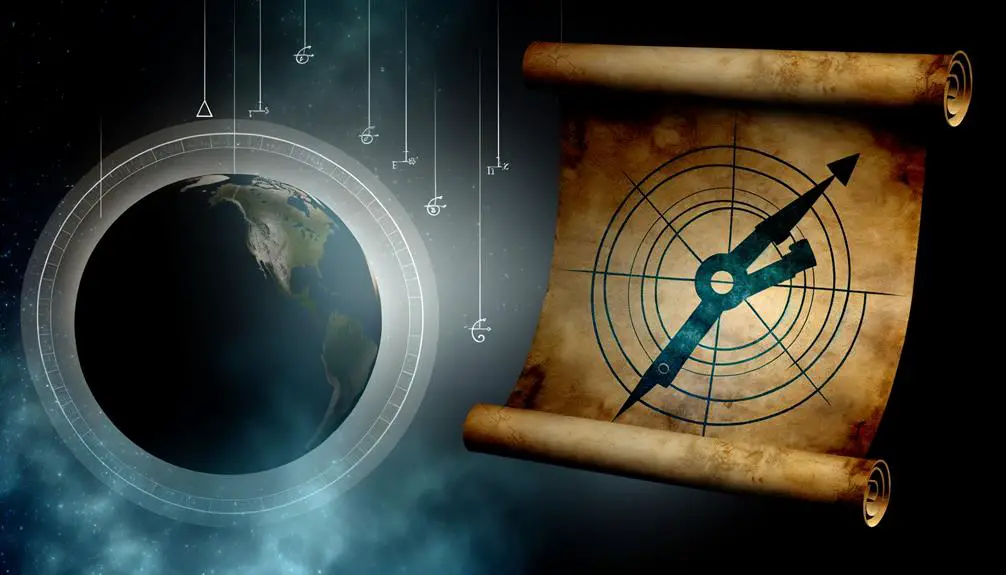Scientific secrets buried in the Bible hint at truths discovered centuries later; delve into how faith and science intertwine.

Scientific Discoveries in the Bible
Have you ever pondered if the Bible harbors insights into scientific discoveries long before they were recognized by modern science? From the shape of the Earth to the expanding universe, the cycle of water, the complexity of life, and even the value of Pi, the scriptures seem to touch upon concepts that scientists only much later confirmed.
This intriguing intersection of faith and science invites you to explore how ancient texts might align with contemporary scientific understanding. Unpacking these claims not only challenges the boundaries of belief and knowledge but also promises to enrich your perspective on the ancient world's wisdom.
Key Takeaways
- The Bible contains early insights into the water cycle, reflecting understanding of evaporation, condensation, and precipitation.
- Biblical texts hint at the expanding universe, aligning with modern cosmological discoveries.
- References to the value of Pi in the Bible showcase ancient mathematical knowledge and geometric awareness.
- Biblical descriptions of Earth's shape and natural phenomena demonstrate the sophistication and observational skills of ancient authors.
The Shape of the Earth
The Bible's portrayal of the Earth's shape has sparked considerable debate and analysis, inviting a closer examination of the texts to discern their implications on our understanding of ancient cosmology. You'll find that within the scriptures, the Earth's form isn't directly described in modern scientific terms, yet the geographical descriptions and references to ancient navigation offer intriguing insights. These elements suggest a perspective that, while not scientifically precise by today's standards, reflects a keen awareness of the world as it was understood in ancient times.
Ancient navigation, as alluded to in the Bible, relied heavily on the stars and the vast expanse of the seas. This reliance indicates a level of sophistication in understanding the Earth's dimensions, even if it doesn't explicitly confirm a spherical Earth as we recognize today. The geographical descriptions found within the Bible also contribute to this discussion, painting a picture of a world that was vast yet navigable, with varying terrains and boundaries that were known and sometimes meticulously described.
This analysis doesn't aim to retrofit modern scientific understanding into ancient texts but rather to appreciate the context in which these descriptions were made. It's crucial to recognize that the ancients' conceptualization of the Earth's shape, informed by their observations and the navigational and geographical knowledge of the time, provided a functional understanding of the world that was adequate for their needs.
Understanding this context allows for a more nuanced appreciation of how the Earth's shape is presented in the Bible, bridging the gap between ancient and modern cosmologies without diminishing the significance of either.
The Expanding Universe

While exploring the shape of the Earth offers a glimpse into ancient understandings, examining biblical references to the expanding universe reveals a surprising alignment with modern cosmological discoveries. The concept of a universe that stretches out, an idea present in ancient texts, correlates intriguingly with what you've learned from Hubble's Law and the observation of cosmic background radiation—two pillars of modern cosmology that underscore the dynamic nature of the cosmos.
Hubble's Law, formulated in the 20th century, provides empirical evidence for the expansion of the universe, demonstrating that galaxies are moving away from us at speeds proportional to their distances. This discovery fundamentally altered your understanding of the universe, suggesting it had a beginning and has been expanding ever since. Similarly, cosmic background radiation, the afterglow of the Big Bang, offers a snapshot of the infant universe, further corroborating its expansion from a hot, dense state.
Biblical Concept |
Modern Discovery |
|---|---|
Stretching of the heavens |
Hubble's Law |
Creation from a singular beginning |
Cosmic background radiation |
Infinite expanse of the universe |
Expanding universe model |
These parallels aren't to suggest that ancient texts explicitly detailed these complex cosmological concepts as understood today. Instead, they hint at a remarkable congruence between ancient metaphorical descriptions and contemporary scientific findings. By examining these ancient writings through the lens of modern science, you uncover a fascinating dialogue between past and present, where metaphorical and empirical understandings of the universe reflect and enrich each other.
The Cycle of Water

Understanding the cycle of water through a modern scientific lens illuminates its early descriptions found within biblical texts, showcasing an ancient insight into this fundamental natural process. This reflection not only underscores the prescient understanding of natural phenomena but also highlights how these ancient descriptions align with contemporary scientific knowledge about the hydrological cycle.
The cycle of water, as we understand it today, involves the evaporation of water from surfaces, predominantly oceans, its transportation in the air, condensation into clouds, and precipitation as rain or snow, which either infiltrates the ground or returns to the oceans through rivers and streams. Remarkably, biblical passages allude to this cycle in a manner that resonates with our current understanding.
Your analysis of these texts reveals an appreciation for the complexity of rainfall patterns and the role of ocean currents in distributing water around the globe. The ancient authors mightn't have had the scientific terminology we use today, but their observations reflect a nuanced understanding of these processes. For instance, discussions of rain providing nourishment to the earth hint at an understanding of precipitation's role in the water cycle and its significance for life.
Moreover, the mention of ocean currents in these texts points to an early recognition of the oceans' dynamic nature and their importance in the global distribution of water. This insight is particularly striking, considering the limited observational tools available at the time.
The Complexity of Life

Exploring further, scientific insights found in biblical texts extend beyond natural phenomena to grapple with the complexity of life itself, inviting a closer examination of ancient wisdom in light of modern biological understanding. This exploration reveals that ancient texts, including the Bible, may have intuited aspects of what contemporary science understands about genetic diversity and cellular mechanisms, albeit in a non-technical language.
The concept of genetic diversity, crucial for the survival and adaptation of species, finds a parallel in the biblical emphasis on the variety and multiplicity of life. While the ancient texts don't detail DNA or genes, they acknowledge the vastness and intricacy of life forms, suggesting a recognition of the underlying complexity that modern genetics has unveiled.
Similarly, the Bible's references to the breath of life and the flesh as a canvas of existence hint at an understanding of life's fragility and complexity. These descriptions can be seen as early attempts to grapple with the cellular mechanisms that sustain life. Modern biology reveals that cells are the basic units of life, responsible for an organism's growth, development, and reproduction. The biblical narrative, in its poetic language, seems to echo this understanding by highlighting the interconnectedness and the intricate design of living organisms.
In analyzing these texts, it's clear that while the ancient authors lacked the scientific terminology and tools that researchers have today, they possessed a profound respect for life's complexity. This respect, bridged with contemporary scientific knowledge, enriches our understanding of how ancient wisdom and modern science converge in their appreciation of life's intricate design.
The Value of Pi

The biblical text subtly encapsulates mathematical wisdom, as evidenced by its reference to the value of Pi, an essential constant in geometry. This intriguing aspect invites you to delve into the historical interpretations and mathematical approximations that have been debated over centuries. The Scripture mentions the dimensions of a circular object, which, when calculated, suggests an approximation of Pi. This has sparked considerable discussion among scholars and mathematicians regarding the accuracy and intention behind these references.
You'll find that historical interpretations often hinge on the understanding of numerical values and measurements used in ancient times. These interpretations suggest that the biblical authors possessed a sophisticated level of mathematical knowledge, albeit expressed within the limitations of their era's numerical systems. The approximate value of Pi, as derived from the biblical text, may not match modern calculations precisely, but it demonstrates an awareness of geometric principles that were ahead of their time.
Moreover, the mathematical approximations found in the Bible reflect the broader context in which these texts were written. They reveal an attempt to understand and describe the world using the mathematical knowledge available at the time. It's important to consider these approximations within their historical and cultural context, recognizing them as part of humanity's ongoing quest to comprehend the complexities of the universe.
As you explore the value of Pi in the biblical text, it's essential to approach the subject with an appreciation for the interplay between faith, mathematics, and historical context. This analysis not only enriches your understanding of ancient texts but also highlights the enduring nature of mathematical exploration in human history.
Frequently Asked Questions
How Does the Bible Address the Concept of Time Relative to Modern Understandings of Time Dilation and Relativity?
You're exploring how the Bible addresses time, especially in light of modern concepts like time dilation and relativity. It doesn't directly tackle these scientific theories, but it presents time as a platform for timeless morality and prophetic accuracy.
These aspects suggest a different, more philosophical approach to understanding time, rather than a strictly scientific one. The Bible's take on time offers a unique perspective, intertwining spiritual significance with the passage of time.
In What Ways Does the Bible Reference or Align With the Principles of Quantum Mechanics or the Behavior of Particles at the Atomic and Subatomic Level?
You're exploring how the Bible might hint at quantum mechanics, like Heisenberg's Uncertainty Principle or Wave Particle Duality, without directly mentioning them. It's an intriguing quest, like uncovering a hidden layer in an ancient manuscript.
However, while the Bible delves into many profound topics, its references to natural phenomena are metaphorical or allegorical, rather than scientific descriptions. Thus, any parallels you find are more about philosophical alignment than direct scientific reference.
Are There Any Biblical Passages That Hint at the Existence of Dinosaurs or Prehistoric Life Forms Not Commonly Known at the Time of Its Writing?
You're looking for biblical passages that might hint at dinosaurs or prehistoric life. The Leviathan description and Behemoth interpretation are often cited in these discussions.
Critics argue these descriptions are too vague to confirm such a link definitively. Instead, they suggest these references could symbolize chaos or power rather than specific creatures.
It's intriguing to ponder, yet the evidence doesn't conclusively prove the existence of dinosaurs in the biblical text.
How Does the Bible Approach the Topic of Genetic Diversity and Inheritance, Especially in Light of Contemporary Discoveries in DNA and Genetics?
You're exploring how the Bible approaches genetic diversity and inheritance. It doesn't directly discuss DNA or modern genetics but offers insight through genealogical narratives and Levitical laws. These elements reflect an understanding of lineage and inherited traits, aligning with contemporary discoveries in a broad sense.
However, the Bible's focus is more on social and moral implications of lineage rather than the scientific mechanisms of genetics, making direct comparisons somewhat challenging.
Does the Bible Contain Any References or Insights Into the Nature of Dark Matter or Dark Energy, Considering Their Significance in Current Astrophysical Research?
You're exploring whether the Bible delves into concepts akin to dark matter or dark energy, pivotal in modern astrophysics. While it doesn't explicitly mention these terms, you might find cosmic symbolism and metaphysical interpretations that resonate with the mysterious nature of these phenomena.
Analyzing biblical texts through a scholarly lens, you'll discern that its focus is more on existential and spiritual questions rather than detailing the fabric of the universe's physical properties.
Conclusion
As you've journeyed through the intertwining paths of faith and science, you've encountered astonishing intersections where biblical texts hinted at realities only later confirmed by science. From the Earth's shape to the universe's expansion, water cycles, life's complexity, and even the value of Pi, these insights provoke awe and wonder.
Yet, the question lingers: what other secrets lie veiled within ancient scriptures, awaiting discovery? This exploration, far from over, continues to bridge divides, challenging and expanding our understanding of the universe.



Sign up